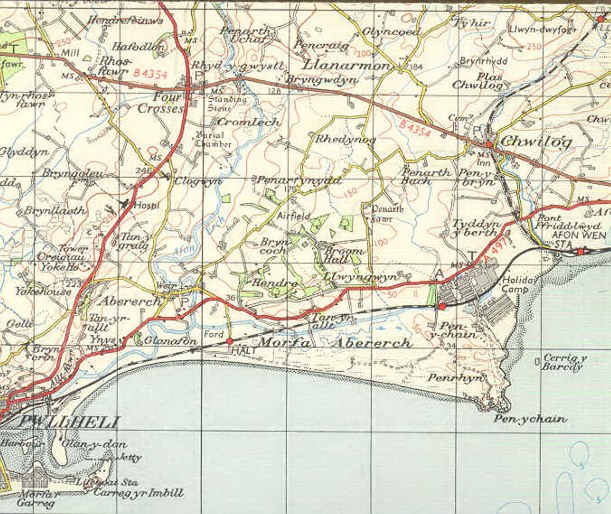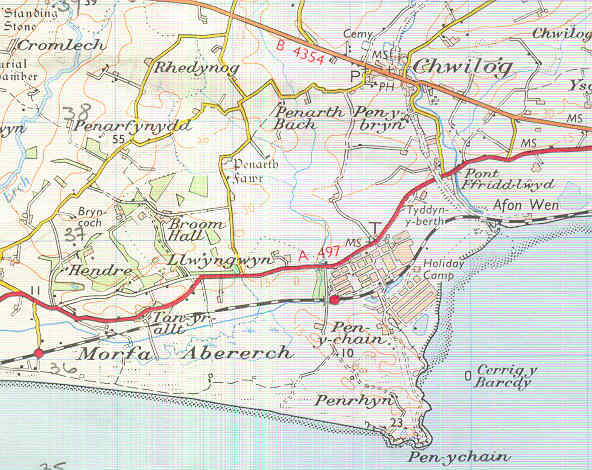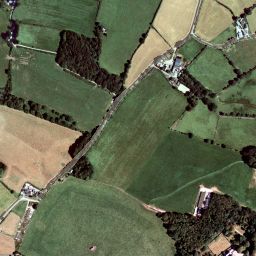Ayr | Barry Island | Bognor Regis | Clacton | Filey | Minehead | Mosney | Pwllheli | Skegness
by Robert Owen
On my bookshelf stands a crime-fiction paperback published in 1963 by Panther Books entitled The Toff at Butlin's'' - a novel by John Creasey that was originally published in 1954 by Hodder & Stoughton Ltd. This particular paperback edition is signed by a neighbour of my late parents' and is dated January 1964.
To quote the from the review on the back cover: Once again the indomitable Toff goes more than halfway to meet trouble - this time in the gay carefree atmosphere of a Butlin's holiday camp - where sinister disappearance of three Redcoats sets him on the trail of MURDER!
Where did such fictional crime take place? The answer is at the Butlin's Camp - Pwllheli. Why do I still keep this novel whose pages have become yellow with the passage of time? Well, because my childhood was spent living within about 2 miles of the Camp and the map of the site, included near the front of the book, often came in handy when visiting, or indeed working at, this once renowned Holiday venue.
Chapter Three of the novel reminds me of the local pleasure flights that were available for Campers - to enjoy an aerial view of the Camp site and the surrounding Welsh scenery. Of course, these days one is also reminded of the BBC comedy series Hi-De-Hi - whenever we hear the sounds 'Bing, bong - hallo campers...' The book records a female voice announcing over the Tannoy Public Address system:
Hallo, campers, this is radio Butlin's calling. She paused. It is half-past four, and we want to remind you of the evening's programme. But before that, we can tell you that (sky) visibility is perfect - and conditions for flying couldn't be better! So why not see this wonderful Camp from the air - as well as the lovely Cardigan Bay, the Welsh coast, and all the beauty of the countryside?
Free transport will take you straight to the airfield at four-forty-five and again at seven-thirty, after dinner. If you haven't yet had this wonderful flight, now is the time. Dinner, of course, is at six-thirty. Then for tonight...
Like the map of the Camp at the front of the book, the airfield and pleasure flights were indeed not fictional in the slightest. They were all very much fact and of great interest to any young child who was fascinated by all things mechanical - and aeroplanes in particular.
The airfield from where the flights were run was about one-and-a-half miles due west of the Camp in the grounds of a country manor estate by the name of Broom Hall (or Broomhall). The runway itself was a grass-strip that ran in a north-east to south-west direction. Close by, there was a large, old, corrugated-steel, curved-roof aircraft hangar at the rear of which was another much smaller and newer metal hangar that was painted to blend with the trees that encircled most of the southern side of the airfield. At each end of the runway strip was a tall white pole supporting a bright orange-yellow colour windsock carrying the lettering 'SHELL' in large, red capitals.
A dirt-track cut across the middle of the airfield from north-west to south-east. This provided access from the northern Estate Lodge to both the Estate Farm and Manor House which were situated to the south of the airfield and largely surrounded by dense woodland. Where the dirt-track joined the metalled road near the old hangar was a mobile air-traffic control room painted in a bold black and white block-pattern. From there the tree-lined, metalled road proceeded south and eastwards; eventually joining the A497, Porthmadog to Pwllheli road, about half-a-mile west of the Camp main-entrance. (See extract, below, from old One-inch O.S. Map Sheet 115-Pwllheli)

O.S. Map extract © Crown copyright 1962
For me the airfield was just over a 1-mile cycle-ride from home and was always a favourite location to pass - in the hope of seeing an aircraft either taking-off or landing. A good viewing point for the airstrip was either from a gate on the northern side of the airfield or from the dirt-track by the north Lodge gate.
The lucky Campers taking the pleasure-flights were bussed from Butlin's to Broom Hall airfield in a small yellow or yellow / blue minibus; possibly a Bedford CA or similar vehicle of the period. This would wait by the large hangar until the aircraft returned after its 15 to 20 mins. flight - in order to ferry passengers back to the Camp.
I recall seeing up to three aircraft at the airfield at any one time; however, the pleasure flights were invariably undertaken using only one aircraft - operating alone possibly for air traffic control / safety reasons. The single, most notable, aircraft was a twin-engined De-Havilland Dragon Rapide bi-plane of 1930s vintage. The earliest I recall being painted grey; however a later (or possibly the same) aircraft was a deep-red colour. These planes could carry up to 7 or 8 passengers at a time. A similar plane has, up until recently, been flying tours of Snowdonia from Caernarfon Airport at Dinas Dinlle; some 13 miles due north of the Butlin's Camp. There is also a static Dragon Rapide mock-up plane outside the Marriott Hotel at the Speke Aerodrome, Liverpool.
Thanks to C Morris for informing us that the De-Havilland Dragon Rapide was owned by a husband and wife team, Chris & Claire Roberts - CHRISAIR. Mrs Roberts was the pilot & her husband (who was also a pilot) would ferry passengers in his Bedford minibus. The flight tickets cost 10 shillings but C Morris & his friend were very lucky that Mrs Roberts kindly let them have a free flight as they lived nearby & were always watching the planes come & go. The planes can be seen here & here
Other smaller aircraft seen operating from Broom Hall airfield were then more recent, single engined, monoplanes capable of carrying no more than four occupants. The aircraft would take-off into the prevailing south-westerly wind; more rarely take-off would be in the opposite direction - if the wind direction had turned to north-easterly.
Once all the passengers were on board and the pilot had completed all his pre-flight checks the twin engines of the Dragon Rapide would be fired-up individually. After a short while, there would be a significant rise in both engine speed and noise prior to the aircraft taxiing along the slightly undulating grass towards the runway threshold.
Here the Dragon Rapide would wait a short while until the engines were revved-up to their full power and then the aircraft would begin rolling forward with ever increasing momentum. As the aircraft accelerated, the fuselage tail could be seen rising and the tail wheel losing contact with the uneven grassy runway. A few seconds later the front wheels - located beneath the engine pods- would also rise above the grass strip and the Dragon Rapide would be airborne. Any pilot worth his salt usually had the aircraft airborne before reaching the access dirt-track that crossed the airfield. If not, the passengers must surely have felt a jolt as the wheels traversed the ruts in the track.
The aircraft having taken-off towards the south-west would continue to climb - up to about 1500 feet - out towards the sandy coastline of Cardigan Bay. Then it would turn to its port (left) side and head towards Butlin's where the pilot would do a complete circuit of the Camp before turning the aircraft back towards the Broom Hall airstrip.
Provided that the wind was from the south-west, the aircraft would now approach the airstrip from the north-east. It was always a great feeling to be at this end of the airfield - adjacent to Rhedynog Isaf farmhouse - as the aircraft had to fly above the public road immediately prior to crossing over the perimeter wall into the airfield.
This meant that one could get quite close to the over-flying aircraft since the pilot had no choice other than to be positioned as low as possible at this point in the flight path - in order to make best use of the airstrip length available for the landing.
After the aircraft had landed and taxied back to the apron in front of the large hangar, the passengers would disembark and the awaiting minibus would transport them back to the Camp after what must surely have been a memorable, albeit fairly brief, flight.
Although I never took one of these flights myself, I did once venture, with my father, down towards the hangars when aircraft were present, though not flying. My father spoke awhile to the pilot who was kind enough to allow us inside the Dragon Rapide's passenger compartment so that we could view the flight deck from within.
We would often see the planes taking-off and landing from our village. When viewed, they appeared as if emerging from or descending into the tall trees that encircled the Broom Hall Estate. Those indeed were the days - the good old days - 40 years ago!
The Broom Hall airfield was not listed as such in the O.S. 1:50,000 First Series map (Sheet 123) of the early 1970s and the site is now pastureland - as was frequently the case during the winter months when Butlin's Camp closed down for the off-season.

O.S. Map extract © Crown copyright 1974
Butlin's Camp was normally only open to holidaymakers and day-visitors between the months of May and September of each year. The season ended with the annual Butlin's Eisteddfod on the last Saturday of the opening period. Christmas / New Year and Easter bookings were not available until at least the late 1970s / early 1980s.
Until fairly recently the Broom Hall Manor House had been up for sale. It is now being re-developed, I believe, into luxury apartments and / or guest accommodation.

An aerial photograph of the old Broomhall grass airstrip. Image © Getmapping Plc
Article © Robert Owen - October 2004